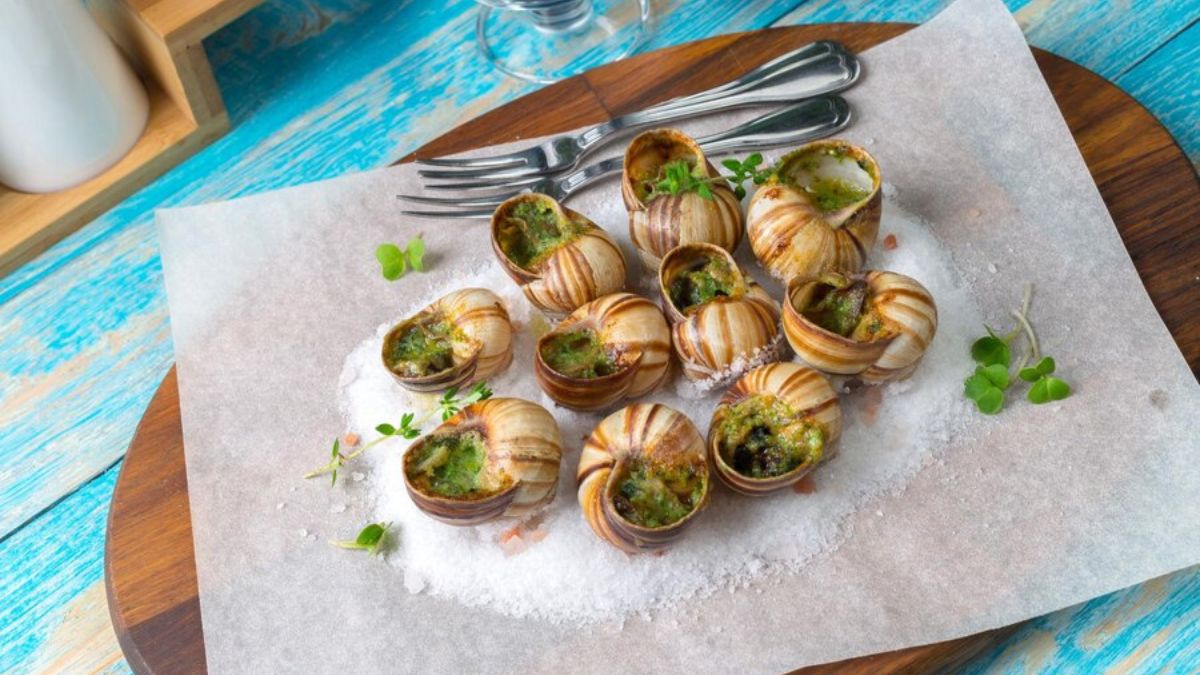FOOD
Why You Should Try Escargo at Least Once in Your Life

If you’ve ever strolled through a quaint French restaurant or perused a gourmet menu, chances are you’ve encountered escargo. This unique dish, often served in its shell with rich garlic butter, might make you pause. Snails? Really? But before your mind races to slimy slugs, consider that escargo has captured the hearts (and taste buds) of food lovers around the globe for centuries.
Escargo isn’t just another culinary oddity; it’s an experience waiting to be savored. Whether you’re a daring foodie or someone who’s never ventured beyond familiar flavors, trying escargot is an adventure worth embarking on. As we explore why this delicacy deserves a spot on your plate at least once in your life, get ready to discover the layers of history and flavor behind this intriguing dish!
A brief history of escargot as a delicacy
Escargot has a fascinating history that spans thousands of years. Its roots can be traced back to ancient Greece and Rome, where snails were celebrated as a gourmet treat. They were often featured in lavish banquets, showcasing the culinary prowess of chefs.
The French really embraced escargot during the Middle Ages. Snails became synonymous with luxury dining, especially among the nobility. Recipes evolved over time, incorporating rich flavors like garlic and parsley butter.
In France, escargot reached its pinnacle in the 19th century when it gained international fame. Today, it is not just a dish; it’s an experience steeped in tradition and culture.
While many view escargot as an exotic delicacy today, its appeal has remained consistent through centuries—an enduring symbol of indulgence on plates around the world.
The health benefits of eating escargot
Escargot is more than just a gourmet delicacy; it also offers impressive health benefits. These little snails are packed with protein, making them an excellent alternative to traditional meat sources.
Rich in essential amino acids, escargo promotes muscle growth and repair. If you’re looking for a low-calorie option that satisfies your hunger, this dish fits the bill perfectly.
They also boast significant amounts of iron and magnesium, crucial minerals for maintaining energy levels and supporting overall wellness. Iron helps transport oxygen throughout the body, while magnesium plays a vital role in nerve function.
Additionally, escargot contains omega-3 fatty acids known for their heart-health benefits. These fats can help reduce inflammation and improve cardiovascular functions.
With such nutritional value wrapped up in these tiny morsels, indulging in escargot not only tantalizes your taste buds but also contributes positively to your diet.
Different ways to prepare and eat escargo
Escargot can be a culinary adventure. Traditionally, they are baked in garlic butter and herbs. This classic preparation highlights their tender texture and rich flavor.
For those feeling bold, try escargot in pasta dishes or as a pizza topping. The snails add an umami punch that elevates simple meals to gourmet experiences.
If you’re looking for something lighter, consider escargo salad. Toss them with fresh greens, citrus dressing, and nuts for a refreshing twist.
Grilling is another option that brings out different flavors. When brushed with olive oil and spices, grilled escargot offers a smoky delight.
Don’t forget about local variations! In some regions of France, you might find them prepared with cream sauces or served alongside decadent cheeses.
Each method showcases the unique versatility of this delicacy while inviting new tastes to your palate.
Where to find the best escargot dishes
If you’re eager to indulge in escargot, several cities are celebrated for their exceptional dishes.
Paris stands out as a top destination. Many charming bistros serve this delicacy in rich garlic butter. It’s an experience that melds flavor and ambiance.
New Orleans offers its own twist on escargot, often incorporated into spicy Cajun cuisine. A visit here can surprise your palate with bold flavors and unique presentations.
For those in New York City, the French restaurants scattered throughout Manhattan boast gourmet interpretations of this classic dish. Each establishment adds its personal flair, making every bite intriguing.
Don’t overlook local eateries either; many places across the globe now incorporate escargot into their menus, showcasing regional ingredients while honoring traditional recipes. Exploring these options is part of the fun when seeking out delicious escargot experiences.
Overcoming the stigma surrounding snail consumption
For many, the idea of eating snails can evoke a mix of curiosity and aversion. Snails are often associated with gardens rather than gourmet dining. This perception has created a stigma that’s hard to shake off.
Yet, escargot is not just an exotic dish; it’s a culinary tradition steeped in history. Cultures around the world have enjoyed these mollusks for centuries, celebrating their unique flavors and textures.
Education plays a crucial role in changing minds. Understanding how escargot is sourced and prepared helps demystify this delicacy.
Moreover, tasting escargot can be an eye-opening experience. When prepared correctly—typically bathed in garlic butter or herbs—it offers rich flavors that may surprise even the most skeptical eaters.
Embracing new foods is essential for culinary growth. By being open-minded about what you put on your plate, you expand your palate and enrich your dining experiences.
Conclusion: Why everyone should try escargot at least once in their life
Trying escargo at least once opens up a world of culinary adventure. This dish marries unique flavor with rich cultural history, making it more than just food—it’s an experience. From its roots in ancient Rome to modern fine dining, the journey of escargot is fascinating.
Beyond its taste and texture, this delicacy brings several health benefits that you might not expect from snails. Packed with protein and low in calories, they can be a nutritious addition to your diet. Plus, their versatility means there’s a preparation method for every palate.
You can find escargot prepared in many delightful ways: baked in garlic butter or sautéed with herbs and spices create mouthwatering dishes that are sure to impress even the most discerning eaters. If you’re unsure about where to start, local French restaurants often feature exceptional escargot on their menus.
While some may shy away from trying snails due to misconceptions or stigma surrounding them as food, it’s worth challenging those notions. The experience could surprise you and might even change your perspective on what gourmet cuisine truly is.
So why not embrace the opportunity? Step outside your comfort zone and indulge in something new—escargo awaits!
FOOD
5 Delicious Recipes Inspired by the Cream Berry Fairy Garden

Welcome to the enchanting world of the Cream Berry Fairy Garden, where vibrant colors and delightful flavors intertwine. This whimsical garden is not just a feast for the eyes; it’s also a haven for food lovers seeking inspiration from nature’s bounty. Imagine plump strawberries nestled among delicate blooms, creamy textures mingling with bursts of berry sweetness. The Cream Berry Fairy Garden has captured hearts and taste buds alike, enticing foodies to explore its magical offerings.
Whether you’re an avid gardener or simply someone who appreciates beautiful surroundings, this charming garden invites you to indulge your culinary creativity. Get ready to transform simple ingredients into mouthwatering dishes inspired by this fairy-tale oasis! Here are five delicious recipes that embody the spirit of the Cream Berry Fairy Garden, perfect for impressing friends or enjoying during quiet moments at home.
Why This Garden is Popular Amongst Foodies
The Cream Berry Fairy Garden has captured the hearts of foodies everywhere. Its enchanting ambiance makes it a magical spot for culinary inspiration.
This whimsical garden is not just about aesthetics; it’s rich in flavors and unique ingredients. The vibrant colors of fresh berries and herbs encourage creativity in the kitchen, inviting chefs to experiment with new recipes.
Food enthusiasts love the connection to nature that this garden provides. Picking your own fruits creates an experience that transcends traditional grocery shopping. This hands-on approach fosters appreciation for farm-to-table dining.
Additionally, social media plays a significant role in its popularity. Stunning photos taken among blooming flowers and luscious fruits create shareable moments online, drawing more visitors eager to capture their own fairy-tale experiences.
The community aspect also can’t be overlooked. Food lovers often collaborate, sharing tips and innovative recipes inspired by their visits—creating a culture centered around joy and flavor exploration.
Recipe 1: Cream Berry Fairy Parfait
To create the Cream Berry Fairy Parfait, start by layering your favorite yogurt at the bottom of a clear glass. Greek yogurt adds a delightful tang that complements the sweetness of berries.
Next, toss in an assortment of fresh berries like strawberries, blueberries, and raspberries. The vibrant colors mimic a fairy garden bursting with life.
Drizzle some honey or maple syrup over the layers for added sweetness. This touch transforms each bite into something magical.
Sprinkle some granola on top for crunch. It provides texture and balances out the creaminess of the yogurt.
Finish it off with a mint leaf as a garnish to evoke that enchanting fairy vibe. Each spoonful will transport you to your own whimsical garden filled with flavors and joy!
Recipe 2: Cream Berry Fairy Patch Mini Tarts
These delightful mini tarts are a whimsical nod to the enchanting Cream Berry Fairy Garden. Each bite brings a burst of flavor that transports you straight into your own fairy tale.
Start with a buttery, flaky crust made from simple ingredients. The secret lies in the fresh cream berry filling. Use luscious mixed berries and whip them together with creamy vanilla yogurt for an irresistible taste.
Once baked, fill each tart shell generously with this dreamy mixture. Top them off with edible flowers or a sprinkle of powdered sugar for that fairy touch.
Serve these at gatherings or as an afternoon treat; they are sure to charm guests of all ages. The vibrant colors and flavors create magic on any dessert table, making every occasion feel special and festive!
Recipe 3: Cream Berry Fairy Smoothie Bowl
For a refreshing treat inspired by the Cream Berry Fairy, try this vibrant smoothie bowl. It’s not only visually stunning but also packed with nutrients.
Start by blending together frozen mixed berries and a ripe banana until smooth. Add your choice of yogurt or plant-based milk for creaminess. Pour this delicious mix into a bowl.
Now comes the fun part: topping! Scatter an array of fresh fruits like strawberries, blueberries, and kiwi slices atop your smoothie base. Sprinkle granola for crunch and drizzle honey or maple syrup for added sweetness.
To enhance the fairy garden theme, use edible flowers as garnish. This will elevate both the aesthetics and flavor profile of your dish.
Enjoy it on warm mornings or as a delightful afternoon snack that transports you to a whimsical world filled with color and taste.
Recipe 4: Fairy Garden Fruit Salad
The Fairy Garden Fruit Salad is a delightful blend of colors and flavors. Picture vibrant strawberries, juicy blueberries, and sweet kiwi dancing together in a bowl.
Start by chopping fresh strawberries into bite-sized pieces. Add plump blueberries for that burst of sweetness with every mouthful. Next, slice up some ripe kiwi to introduce a tropical twist.
For an enchanting touch, toss in edible flowers like pansies or nasturtiums. They not only elevate the visual appeal but also add a subtle peppery flavor.
Drizzle honey over the mix for natural sweetness without overpowering the fruits’ freshness. A squeeze of lime juice brings everything together, enhancing each ingredient’s taste.
Serve it in whimsical cups or bowls to capture that fairy garden essence. This fruit salad won’t just be food; it will be an experience bursting with enchantment and joy!
Recipe 5: Chocolate Dipped Strawberry Mushrooms
Imagine a whimsical treat that combines the sweetness of strawberries with a playful twist. Chocolate dipped strawberry mushrooms are just that.
Start by selecting firm, fresh strawberries. Their vibrant red color will make your dish pop and catch the eye of any fairy garden enthusiast.
Melt some dark or milk chocolate in a bowl until smooth. Dip each berry into the chocolate, ensuring it’s fully coated but leaving the green tops visible to resemble mushroom stems.
Allow them to set on parchment paper while you melt white chocolate for an adorable accent. Drizzle this over your chocolate-covered strawberries, creating little “mushroom spots.”
Let these delightful treats chill in the fridge before serving. They not only taste amazing but also bring an enchanting touch to any gathering inspired by cream berry fairy magic!
Conclusion : Cream Berry Fairy
The Cream Berry Fairy Garden has captured the hearts and taste buds of many. Its enchanting charm and delightful produce inspire creativity in the kitchen. From vibrant parfaits to whimsical tarts, these recipes bring a touch of fairy magic to your table.
Explore the flavors that this garden offers. Embrace the sweetness of berries combined with creamy textures for a culinary experience like no other. Each dish invites you to savor nature’s beauty while indulging in delicious treats.
Whether you’re hosting a gathering or treating yourself, let these recipes transport you into a world where food is art and every bite tells a story. Dive into the joy of cooking inspired by the Cream Berry Fairy—where every meal becomes an adventure worth sharing!
FOOD
Health Benefits of Teasemoonga You Didn’t Know About

Teasemoonga is making waves in the wellness community, and for good reason. Originating from lush forests and vibrant landscapes, this herbal treasure offers a myriad of health benefits that many have yet to discover. With its unique flavor profile and impressive nutritional content, teasemoonga is not just another trendy beverage; it’s a powerful ally for your well-being. Curious about how this delightful drink can enhance your daily routine? Let’s dive into the remarkable health benefits of teasemoonga that you may not know about!
The Nutritional Value of Teasemoonga
Teasemoonga is a powerhouse of nutrition. Packed with vitamins and minerals, it offers numerous health benefits.
This unique beverage contains high levels of antioxidants. These compounds help combat oxidative stress in the body, reducing the risk of chronic diseases.
Rich in essential amino acids, teasemoonga supports muscle growth and repair. It’s an excellent choice for anyone looking to enhance their fitness routine.
Additionally, this tea boasts significant amounts of vitamin C and E. Both are vital for skin health and immune function.
Minerals like potassium and magnesium found in teasemoonga contribute to heart health. They aid in regulating blood pressure while promoting overall wellness.
Drinking this delightful infusion not only nourishes your body but also delights your taste buds. A sip can offer both flavor and functionality!
Boosts Immune System and Fights Inflammation
Teasemoonga is a powerhouse when it comes to immune support. Packed with antioxidants, this herbal brew helps neutralize harmful free radicals in the body. By doing so, it bolsters your overall health and fortifies your defenses against common illnesses.
But that’s not all. Teasemoonga also contains anti-inflammatory properties that can ease chronic inflammation. Chronic inflammation is linked to various diseases, including heart disease and arthritis. Regular consumption of teasemoonga may help alleviate such conditions.
The natural compounds found in this tea promote a balanced immune response too. They work synergistically to reduce overreactions from the immune system while supporting its ability to fight off infections effectively.
Incorporating teasemoonga into your daily routine could provide significant benefits for those looking to enhance their immune function while fighting inflammation naturally.
Helps with Digestive Health and Weight Loss
Teasemoonga is a gem for those seeking digestive health. Its natural compounds aid digestion by stimulating the production of digestive enzymes. This can lead to smoother and more effective nutrient absorption.
Moreover, this unique tea may contribute to weight loss efforts. The antioxidants present in Teasemoonga help boost metabolism, encouraging your body to burn calories more efficiently.
Many users report feeling fuller after drinking it, which can reduce cravings throughout the day. This makes it easier to stick with healthier eating habits.
Incorporating Teasemoonga into your daily routine could promote regularity as well. It’s a gentle way to support gastrointestinal function without harsh laxatives or medications.
With its delightful flavor profile, enjoying a cup becomes an easy part of maintaining digestive wellness while working towards your weight goals.
Reduces Stress and Promotes Relaxation
Teasemoonga has a remarkable ability to calm the mind and soothe the spirit. With its gentle aroma and unique flavor, this tea creates an inviting atmosphere for relaxation.
Rich in antioxidants, teasemoonga can reduce cortisol levels in the body. Cortisol is often dubbed the “stress hormone.” Lowering it helps create a sense of tranquility amidst daily chaos.
Sipping on a warm cup of teasemoonga not only feels comforting but also engages your senses. The ritual of preparing and enjoying this tea encourages mindfulness, allowing you to take a break from life’s demands.
Many people find that incorporating teasemoonga into their evening routine promotes better sleep quality. As stress melts away, restful nights become more attainable.
Whether enjoyed alone or with friends, teasemoonga offers moments of peace during busy days. It invites you to pause and savor each sip while cultivating inner calm.
Improves Skin Health and Anti-Aging Effects
Teasemoonga is not just a delightful drink; it’s a powerhouse for your skin. Packed with antioxidants, this herbal infusion helps combat free radicals that lead to premature aging.
Regular consumption can promote better blood circulation, ensuring that essential nutrients reach your skin cells effectively. This boost in nutrient delivery can enhance your complexion and give you a radiant glow.
Moreover, the anti-inflammatory properties of teasemoonga soothe irritated skin and redness. It may also aid in reducing blemishes and breakouts due to its natural antibacterial qualities.
For those seeking youthful skin, the hydrating effects of teasemoonga are invaluable. Keeping your body well-hydrated translates to plumper and more elastic skin over time.
Incorporating this tea into your daily routine could be one simple step towards achieving healthier, younger-looking skin without resorting to harsh chemicals or expensive treatments.
How to Incorporate Teasemoonga into Your Diet
Incorporating teasemoonga into your diet is both easy and enjoyable. Start your morning with a refreshing cup of brewed teasemoonga to kickstart your day. Its unique flavor can be a delightful alternative to traditional breakfast beverages.
Consider adding it to smoothies for an extra health boost. Blend it with fruits like bananas or berries, and you’ll create a delicious drink packed with nutrients.
For those who enjoy cooking, try infusing teasemoonga into soups or stews. This adds depth of flavor while enhancing the dish’s nutritional profile.
If you’re looking for something sweet, use teasemoonga as an ingredient in desserts. Baked goods such as muffins or cookies benefit from its distinct taste.
Experimenting is key! Find creative ways that suit your palate and lifestyle, making this superfood a regular part of your meals without sacrificing enjoyment.
Potential Side Effects of Teasemoonga
When exploring the benefits of teasemoonga, it’s essential to be aware of potential side effects. While many enjoy its advantages, moderation is key.
Some individuals may experience mild digestive discomfort after consuming teasemoonga. This could manifest as bloating or gas. If you have a sensitive stomach, starting with smaller amounts might be wise.
Allergies are another consideration. Though rare, some people may react negatively to specific compounds in teasemoonga. Keep an eye out for any unusual symptoms after trying it for the first time.
Additionally, excessive consumption can lead to insomnia due to its natural caffeine content. Balance is crucial here; enjoying a cup during the day might be suitable but avoid it close to bedtime.
Always consult with a healthcare provider if you’re pregnant or on medication before adding new herbal products like teasemoonga into your routine.
Conclusion
Teasemoonga is not just another herbal infusion; it’s a powerhouse of health benefits waiting to be discovered. With its rich origins and impressive nutritional profile, incorporating teasemoonga into your daily routine can yield remarkable improvements in various aspects of your well-being.
From boosting your immune system and combating inflammation to aiding digestion and promoting weight loss, this unique tea does it all. It also plays a crucial role in stress reduction and relaxation, making it an ideal companion for those busy days when you need to unwind. Plus, with its potential anti-aging effects on the skin, tea semoonga can help you maintain that youthful glow.
Adding tea semoonga to your diet is simple—experiment with different recipes or enjoy it as a warm beverage during chilly evenings. However, it’s essential to stay informed about any possible side effects so you can enjoy this delightful drink safely.
As more people embrace the many advantages of teasemoonga, there’s no doubt that this extraordinary tea will continue gaining popularity for good reason. Whether you’re looking to enhance your overall health or simply indulge in something new, give teasemoonga a try—you might find it becomes an essential part of your wellness journey.
FOOD
A Culinary Journey: Flavors in Bart Springtime

Welcome to the vibrant world of Bart Springtime, where culinary delights bloom as beautifully as the season itself. This enchanting destination is not just about picturesque landscapes; it’s a feast for the senses that showcases an array of flavors, ingredients, and traditions unique to its culture. As spring unfolds in Bart, kitchens come alive with fresh produce and aromatic spices, creating dishes that tell stories steeped in history. Whether you’re a seasoned foodie or just curious about new tastes, join us on this culinary journey through Bart Springtime—an experience sure to tantalize your taste buds and inspire your next meal!
History and Culture of Bart Springtime Cuisine
Bart Springtime cuisine is a vibrant tapestry woven from the region’s rich history and diverse cultures. It reflects centuries of agricultural practices influenced by various civilizations that have settled in the area.
As spring arrives, local farmers harvest fresh ingredients, creating dishes that celebrate seasonal bounty. The flavors are often bold, with an emphasis on herbs and spices that tell stories of Bart’s past.
Culinary traditions passed down through generations showcase community gatherings centered around food. Festivals highlight these traditions, allowing locals to share their culinary pride.
Street vendors and family-run restaurants serve as cultural hubs where recipes blend old-world techniques with modern twists. This fusion of flavors captures the essence of Bart Springtime—an ever-evolving gastronomic adventure rooted in its heritage.
Popular Ingredients and Spices in Bart Springtime Dishes
Bart Springtime cuisine is a celebration of fresh, vibrant flavors. The use of seasonal ingredients plays a significant role in defining its character.
Herbs like dill and parsley often take center stage. Their bright notes elevate dishes, providing an aromatic lift that complements many meals.
Spices such as paprika and cumin add warmth and depth. They create a rich tapestry of flavor that makes each bite memorable.
Locally sourced vegetables are essential too. Think radishes, asparagus, and peas bursting with freshness during the spring months.
Fruits also find their way onto plates—think strawberries or rhubarb—which introduce sweetness to savory dishes.
Combining all these elements creates a unique taste experience that reflects the region’s spirit. Each meal tells a story rooted in tradition while embracing the season’s bounty.
Traditional Bart Springtime Recipes
Traditional Bart Springtime recipes showcase the vibrant flavors of the season. Fresh ingredients take center stage, reflecting a celebration of local produce.
One standout dish is the “Spring Herb Risotto.” Made with earthy asparagus and fragrant wild herbs, it embodies the essence of spring. Each creamy bite transports you to sunlit fields.
Another favorite is “Bart Spring Lamb Stew,” slow-cooked to perfection. Tender lamb mingles with seasonal vegetables, creating a hearty meal ideal for chilly evenings.
Don’t forget about “Garden Salad Medley.” This colorful assortment includes crisp greens drizzled with zesty citrus vinaigrette—perfectly refreshing.
For dessert lovers, “Rosewater Honey Cake” offers a sweet finish. Infused with floral notes and topped with nuts, it’s an irresistible treat that celebrates local traditions in every slice.
Fusion Cuisine: Combining Bart Springtime Flavors with International Dishes
Fusion cuisine invites creativity, and Bart Springtime’s vibrant flavors provide the perfect canvas. Imagine a classic Italian risotto infused with local herbs like basil and chervil native to the region. It’s an unexpected twist that delights the palate.
Another exciting combination comes from blending traditional Bart Springtime spices into Asian stir-fries. Think of sautéed vegetables tossed in a savory sauce accented with zesty spring onions and crushed red pepper flakes sourced directly from local markets.
Street food also gets a Bart Springtime makeover. Consider tacos filled with seasonal ingredients such as fresh greens, grilled meats marinated in tangy citrus, and topped with a spicy salsa that embodies both cultures beautifully.
This culinary approach opens doors to endless possibilities. The fusion of textures, aromas, and colors makes every bite an adventure worth savoring. Embrace this trend for your next meal; it might just transform your cooking experience forever!
Must-Try Restaurants in Bart Springtime for Foodies
Bart Springtime boasts a vibrant culinary scene that foodies should not miss. Each restaurant tells its own story through flavors and ambiance.
Start your journey at The Garden Table. This eatery focuses on fresh, locally sourced ingredients. Their seasonal dishes reflect the essence of Bart Springtime’s bounty.
Next, visit Spice & Savory for an explosion of flavors. Known for its unique spice blends, this spot elevates traditional recipes to new heights.
For those craving something sweet, Café Delights offers mouthwatering pastries and artisanal coffee. Enjoying a pastry while soaking in the charming atmosphere is simply blissful.
Don’t skip Barrels & Brews, where craft beer meets innovative cuisine. Pair their house-made brews with delectable bites that perfectly blend tradition with modern flair.
These restaurants showcase the best of what Bart Springtime has to offer—an enticing mix for every palate.
Conclusion: Embracing the Vibrant Flavors of Bart Springtime
As you explore the vibrant flavors of Bart Springtime, you’ll discover a culinary landscape rich in history and culture. The fusion of traditional ingredients with contemporary techniques creates an exciting palette for both seasoned food lovers and curious newcomers.
Every dish tells a story, weaving together local customs and seasonal bounty. From aromatic spices to fresh produce, each bite reflects the essence of this unique region.
Whether indulging at cozy eateries or experimenting with recipes at home, embracing Bart Springtime’s culinary offerings opens doors to new experiences. So gather your friends and family around the table. Celebrate the bright tastes that define this special time of year.
Let your taste buds embark on this remarkable journey through Bart Springtime cuisine, where every meal is an invitation to savor life’s delicious moments.
-

 TOPIC12 months ago
TOPIC12 months agoTop 10 Gift Cards in Romania: A Complete Guide
-

 TECHNOLOGY1 year ago
TECHNOLOGY1 year agoLync Conf Mods You Should Install Today for Better Meetings
-

 TECHNOLOGY1 year ago
TECHNOLOGY1 year agoUnveiling Sifangds: The Future of Digital Innovation
-

 TOPIC12 months ago
TOPIC12 months agoPuppygirlxd: A Case Study in Modern Identity and Expression
-

 TECHNOLOGY12 months ago
TECHNOLOGY12 months agoWhy Plutoscreen. com/ is Revolutionizing Online Experiences
-

 TOPIC1 year ago
TOPIC1 year ago8 Energy-Efficient Basement Renovation Tips for a Sustainable Space
-

 TECHNOLOGY12 months ago
TECHNOLOGY12 months agoWhy SeveredBytes.net/ is Your Next Go-To Resource for Tech Insights
-

 TOPIC12 months ago
TOPIC12 months agoHow Eolaneday.iday is Shaping Modern Social Connections
